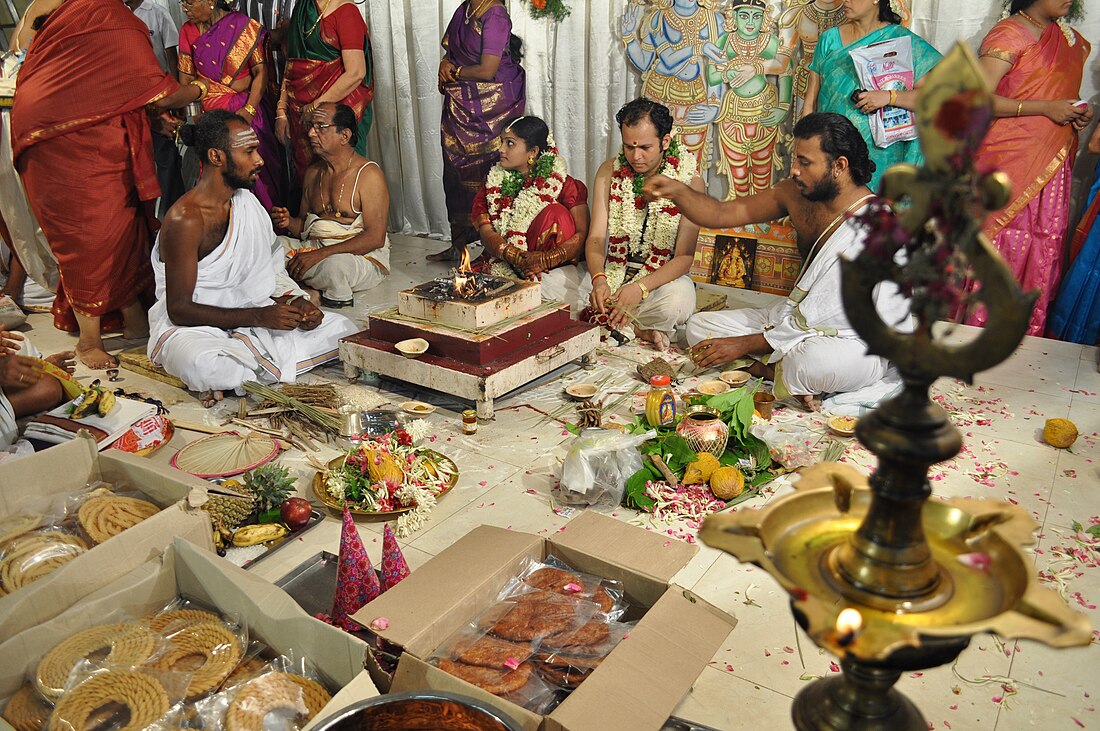Tamil Brahmin
Ethnoreligious community of Hindu Brahmins From Wikipedia, the free encyclopedia
Tamil Brahmins are an ethnoreligious community of Tamil-speaking Hindu Brahmins, predominantly living in Tamil Nadu, though they number significantly in Andhra Pradesh, Karnataka, Kerala and Telangana in addition to other regions of India. They can be broadly divided into two denominations: Iyengars, who are adherents of Sri Vaishnavism, and Iyers, who follow the Srauta and Smarta traditions.[1][2]
 A Tamil Brahmin wedding ceremony | |
| Regions with significant populations | |
|---|---|
| Tamil Nadu, Karnataka, Kerala and Andhra Pradesh | |
| Languages | |
| Tamil, Sanskrit | |
| Religion | |
| Hinduism |
Although they form a tiny minority within their society, the Ceylonese Tamil Brahmins have been integral part of Sri Lankan Tamil community since the foundation of the Jaffna Kingdom by a family of Tamil Brahmins, namely the Aryacakravarti dynasty.[3][4] Their community was mainly strengthened by the more recent settlement of Tamil Brahmins from the Iyer caste in Sri Lanka, mostly from the second half of the 18th century.[5][4][6]
Denominations
Tamil Brahmins are divided into two major denominations: Iyers, who follow the Smarta tradition, and Iyengars, who adhere to the tradition of Sri Vaishnavism.
Iyer
Iyers are Shrauta-Smarta Brahmins, whose members follow the Advaita philosophy propounded by Adi Shankara. They are concentrated mainly along the Cauvery Delta districts of Nagapattinam, Thanjavur, Tiruvarur and Tiruchirapalli where they form almost 10% of the total population. However the largest population reside in Nagercoil, making up to 13% of the city's population.[7][8][9] They are also found in significant numbers in Chennai,[10] Coimbatore, Madurai, Thiruchirappalli, Thanjavur, Palakkad, Alappuzha, Kozhikode, Ernakulam, Kannur, and Thiruvananthapuram.[11]
Iyengar
The Iyengars subscribe to the Visishtadvaita philosophy propounded by Ramanuja. They are divided into two denominations: Vadakalai (Northern art) and Tenkalai (Southern art), each with minor differences in religious rites and traditions. They adhere to the tradition of Sri Vaishnavism.[12]
Adi Saivas/Gurukkal
Brahmins who serve as priests in temples following the Vaishnavite and Shaivite tradition and perform pujas are offered a distinct category classified outside the community by the Government of Tamil Nadu as '703.Adi Saivar' and '754.Saiva Sivachariyar' as distinct from the '713.Brahmanar' (Brahmin) in the list of forward castes. These priests are called "Bhattar" in the Vaishnavite tradition and in the Pandya regions of Tamil Nadu, and "Ayyan" or "Gurukkal" in the shaivite tradition and in northern ones. In Kongu Nadu, they are called Adi Saivas (among other spellings Asishaivas, Adi-Shaivas, etc.; from Sanskrit Ādiśaiva, आदिशैव), or the Sivacharyas. They follow the Agamas and the Vedas.[13]
Notable people
- Sage Agastya, Indian sage revered in Hinduism, Tamil Siddhar in the Shaivism tradition, and author of Agattiyam, an early grammar of the Tamil language[14]
- Rukmini Devi Arundale, Indian classical Bharatanatyam dancer, theosophist, choreographer and an animal welfare activist[15]
- Subramania Bharati, Indian independence activist and poet[16]
- Subrahmanyan Chandrasekhar, Nobel Prize-winning Indian astrophysicist[17]
- J. Sai Deepak, Supreme Court lawyer most famous for his representations in the case on the entry of women to Sabarimala Temple.
- Shyamala Gopalan, American-Indian biomedical scientist, Mother of U.S. Vice President Kamala Harris[18]
- Alladi Krishnaswamy Iyer, Indian lawyer and member of the Constituent Assembly of India responsible for framing the Constitution of India[19]
- Ramanuja (c. 1077–1157 CE), Indian Hindu philosopher, preacher and a social reformer.[20]
- U. V. Swaminatha Iyer, Indian researcher and Tamil scholar[21]
- Kachiyapper (8th century), Indian poet and Vedantist and the author of Kanda Puranam[22]
- K. S. Krishnan, Indian physicist, co-discoverer of the Raman scattering[23]
- Iravatham Mahadevan, Indian epigraphist and civil servant[24]
- Paridhiyaar, medieval Tamil scholar and Kural commentator[25]
- Parimelalhagar, medieval Tamil scholar and Kural commentator[26]
- V. S. Ramachandran, Indian-American neuroscientist specializing in behavioral neurology and known for inventing the mirror box.[27]
- C. V. Raman, Nobel Prize-winning Indian physicist[28]
- Srinivasa Ramanujan, Indian mathematician[29]
- Alladi Ramakrishnan, Indian physicist and founder of the Institute of Mathematical Sciences (Matscience) in Chennai[30]
- Vivek Ramaswamy, American politician and candidate 2024 Republican Party presidential primaries[31]
- Sivananda Saraswati, Indian yoga guru, Hindu spiritual teacher, and proponent of Vedanta[32]
- C. S. Seshadri, Indian mathematician.[33]
- T.N.Seshan, Chief Election Commissioner
- Tolkappiyar, earliest known author and grammarian in Tamil language[34]
- S. R. Srinivasa Varadhan, Indian mathematician and Abel Prize laureate[35]
- Ramaswamy Venkataraman, Indian lawyer, independence activist and politician, who served as the eighth president of India[36][37]
See also
References
Wikiwand - on
Seamless Wikipedia browsing. On steroids.
